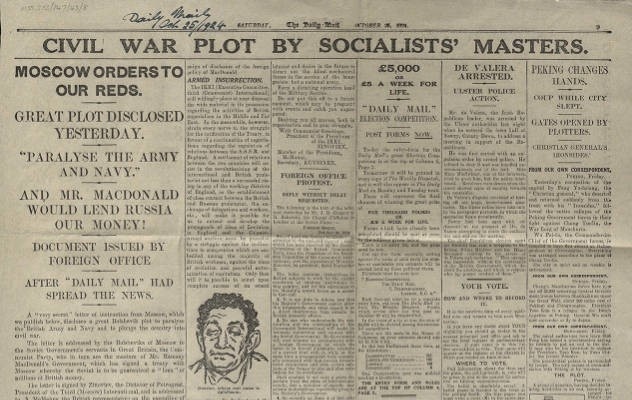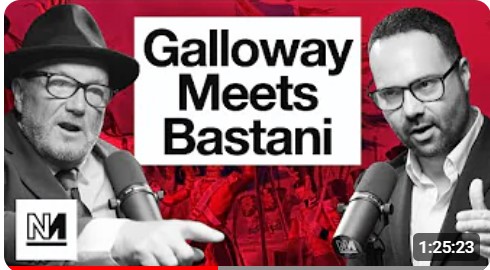Cain O’Mahony looks at the first ever Labour Government in 1924 and the dirty tricks used against it. [featured photo – the Daily Mail front page – October 2, 1924]
*****
2024 is going to be the year of elections, with the UK, USA and India going to the polls. Unfortunately, experts say it will see unprecedented use of ‘deep fake’, thanks to the new availability of cheap Artificial Intelligence platforms.
It’s already under way. On the eve of last year’s Labour Party conference – and only days after Musk had sacked his ‘Election Integrity’ team after taking over Twitter – an AI created fake audio clip purporting to be Keir Starmer swearing at Labour Party staff was circulated on ‘X’. It received a million hits.
Dirty tricks and fake news have always been in the arsenal of the ruling class when threatened by the labour movement. The first such attack was the notorious ‘Zinoviev Letter’ one hundred years ago, after Labour’s first, albeit short-lived, minority government led by J Ramsay MacDonald.
In the January 1924 election, the British establishment had been shocked by the advance of Labour. Although their party, the Tories, won 258 seats, Labour became the second largest party in Parliament with 191 seats, pushing the Liberals into third place, with 158 seats.
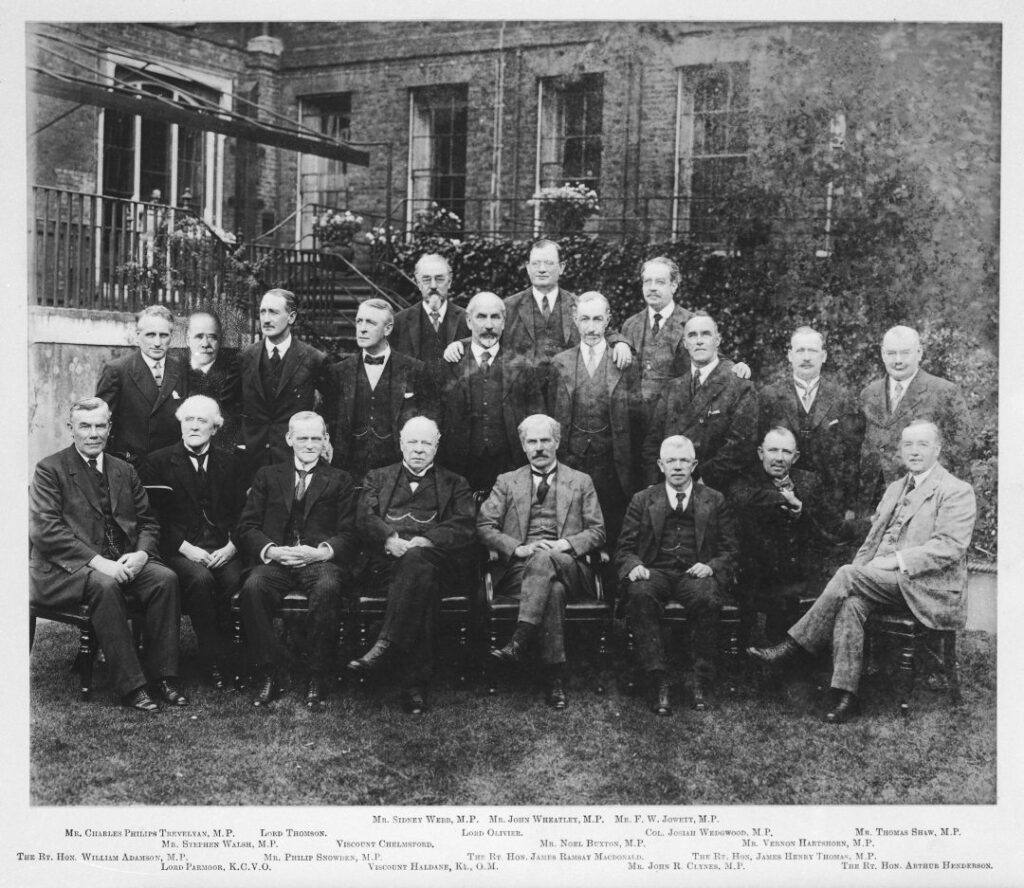
The Tories couldn’t rule, and much to their horror the ‘Tory second eleven’, the Liberal Party, said they would back Labour to form a government. They reassured the ruling class that they could keep Labour under control, with Liberal Leader, Asquith, boasting that Labour would have to “eat from the Liberal hand”.
British Empire terrified
Despite their dismissive behaviour towards Labour, the British Empire – the mightiest institution in the world at this time – was terrified. Revolutions had swept across Europe from the Russian epicentre. While the British ruling class tried to portray revolutionary socialism as something ‘alien’, ‘foreign’, something that had just dropped from the sky, they knew in reality that the seeds of revolt had germinated in the mass workers’ parties, whether the Russian Social Democratic and Labour Party, or the Social Democratic parties in Hungary, Austria and Germany. And now Britain’s new mass workers party was in office.
The sniping began immediately. The Tory press whipped up the first ‘crisis’ on day one, when the new Labour Ministers would have to go to Buckingham Palace to be granted their ‘Seals of Office’ from the King. The British establishment and an army of Palace flunkies confronted the Labour government, saying it was constitutional protocol that they must wear a frock coat and a silk top hat in the presence of His Majesty.
As Labour retorted: “But who of the Ministers drawn from the ranks of Labour possessed a frock coat or a tall hat… they only had with them in London the suits in which they stood” (Vernon Radcliffe, The British Labour Party, 1948).
Such disrespect for the King! However, despite the howls of anguish from the Tory press the attack was soon dropped after they realised that the mass of the nation didn’t give a damn about whether the Labour Party wore top hats or not. The formality was dropped and it was agreed Labour could wear modest lounge suits in presence of the monarchy. Labour – 1, Top Hats – 0.
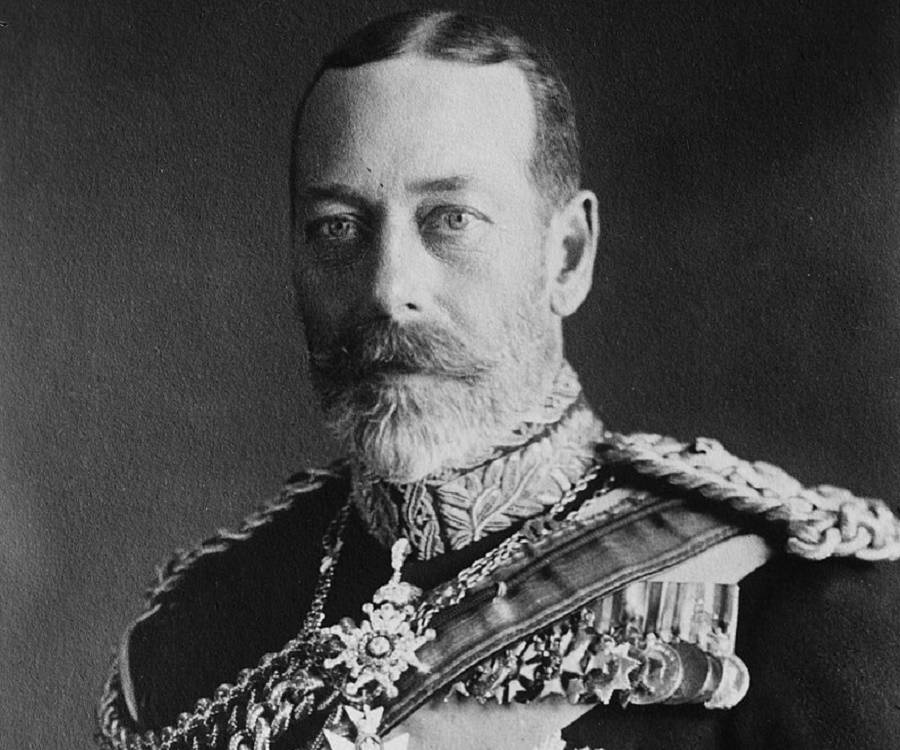
It was clear to the ruling class they would need sharper knives to damage Labour, than worries about Labour’s shortage of top hats.
The Labour government staggered along trying to bring in rises in benefit payments, cuts in arms spending and a house building programme, but they were harried at every step with at times two Liberal MPs voting against the government for every one Liberal MP who supported it.
The crisis came over the new Soviet Russia. The Labour government formally recognised the Russian government, and began trade negotiations and the possibility of British loans to the new state. The anger of the British ruling class reached apoplexy. They said there could be no deals with Soviet Russia until they had paid compensation for British property confiscated during the revolution – total hypocrisy given that Britain was one of the many imperialist nations that tried to invade Russia on the side of the reactionary ‘White’ Russian forces. If anything, Britain owed Russia reparations!
Incitement to mutiny
Then came the JR Campbell case. JR Campbell was editor of the new British Communist journal, the Weekly Worker. It had carried an article titled ‘DON’T SHOOT!’, which was a class appeal to workers in the armed forces not to break strikes. It concluded with the demands:
“Refuse to shoot strikers in industrial disputes!
Refuse to fight for profits!
Turn your weapons on your oppressors!”
The previous Tory government used a law from the Napoleonic wars, the ‘1797 Incitement to Mutiny Act’, to start a prosecution case against Campbell.

Under the new Labour government, the Director of Public Prosecutions dropped the case, pointing to Campbell’s exemplary war record – he had fought and was wounded at both Gallipoli and then the Somme, being awarded the Military Medal for gallantry – and also that it wasn’t unreasonable to ask soldiers not to shoot trade unionists!
The Tories and Liberals wailed that the legal process should take due course and joined together to out vote Labour with a call to set up an investigation into this ‘political interference’. To its credit Labour would not back down and, instead, called a new General Election in October 1924.
On the election trail it became clear that support for Labour was growing – the Tories would need a new approach. Their go-to propagandist at the time was media magnate Lord Northcliffe. Towards the end of World War I, the British hierarchy began to see the value of Northcliffe’s populist tabloid style in ‘selling the war’ to an increasingly weary British public. During the war, Northcliffe had joined the cabinet as director responsible for all propaganda directed at enemy countries.
Northcliffe’s attitude towards Labour was pretty clear:
“The British Labour Party, as it impudently calls itself, is not British at all. It has no right whatever to its name. By its humble acceptance of the domination of the Sozialistische Arbeiter Internationale’s authority at Hamburg in May it has become a mere wing of the Bolshevist and Communist organisations on the continent. It cannot act or think for itself” (Daily Mail, 25 October 1924).
The SAI he refers to was of course set up by the 2nd International Social Democratic Parties in 1924 including Labour, precisely to fight against the new Communist International. But Northcliffe would never let the facts get in the way of a ‘good story’. Socialism was ‘foreign’, unpatriotic and even traitorous.
Mysterious document
So, four days before polling day in October 1924 a mysterious document ‘appeared’ on the desk of the editor of the Daily Mail (owner: Lord Northcliffe). It purported to be a copy of a directive from Grigory Zinoviev, the head of the Communist International (Comintern) in Moscow, to the new Communist Party of Great Britain (CP), stating that the normalisation of British-Soviet relations under the Labour government would radicalise the British working class and put the CP in a favourable position to launch a revolution, and work must get underway to form communist cells in the British armed forces.
The Daily Mail went into red-scare overdrive, its headlines screaming: “CIVIL WAR PLOT BY SOCIALIST MASTERS! Moscow orders to our Reds!” [see featured photo at the top of the article]
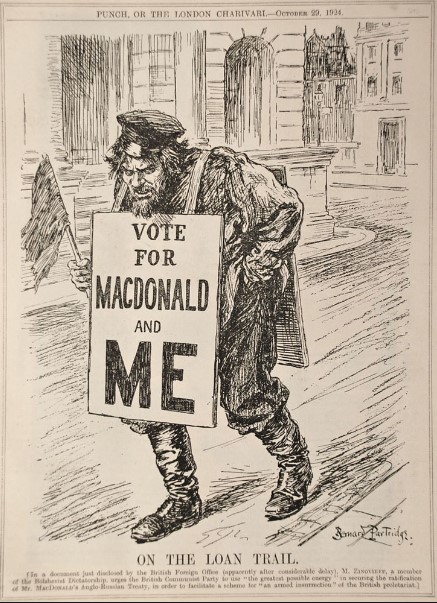
The rest of the Tory press followed the Mail’s lead – even the normally calm Times, at that time the semi-official organ of the British ruling class, roared: “SOVIET PLOT – RED PROPAGANDA IN GREAT BRITAIN – REVOLUTION ORDERED BY ZINOVIEV!” The popular magazine Punch meanwhile carried a large cartoon of a goblin-esque caricature of a hairy Russian Bolshevik carrying a placard declaring: “Vote for MacDonald – and ME”.
Fortunately, the vast majority of the labour movement saw straight through it as a forgery. For a start, it purported to be from the Executive Committee of the “… Third Communist International”. Nobody in the labour movement internationally called it that, friend or foe alike – it was the Comintern. Also, the government of Soviet Russia quickly proved that Zinoviev was not even in Moscow on the day the letter was supposed to have been signed by him.
More to the point, what a coincidence! The two key issues that the Tories and Liberals had attacked the Labour government over was the trade deal with Soviet Russia and the JR Campbell case. And now here was a letter ‘proving’ exactly what they had warned would happen. Fancy that!
But also, everyone knew White Russian emigres were pumping out forgeries left, right and centre to try to win imperialist support for a new war on the Bolsheviks. Similar ‘red letters’ were appearing across the world, from the USA to Bulgaria.
Forgery factory
Indeed, confirmation came eight months after the 1924 election, when police in the Weimar Republic arrested the White Russian, Drushelovsky, after raiding his forgery factory in Berlin. They found stacks of forged letters purporting to be from the Comintern which they hoped would help influence anti-Bolshevik propaganda across the world.
As the Communist Party in Britain pointed out:
“A thoroughly equipped institution created and devoted specifically to the production of forged documents … these discoveries in themselves expose the source, not only of the infamous ‘Red Letter’, but of the forgeries that subsequently made their appearance in Bulgaria, Poland, Germany, France, Italy and America” (History of the Zinoviev Letter – pamphlet produced by the Communist Party of Great Britain, September 1925).
Even so, the Zinoviev Letter did have an impact on the election – but not as planned. There is an expression in military intelligence circles called the ‘black boomerang’. This is where a black ops action appears to have succeeded but then comes back to smack you in the face. The British ruling class made a fundamental error.
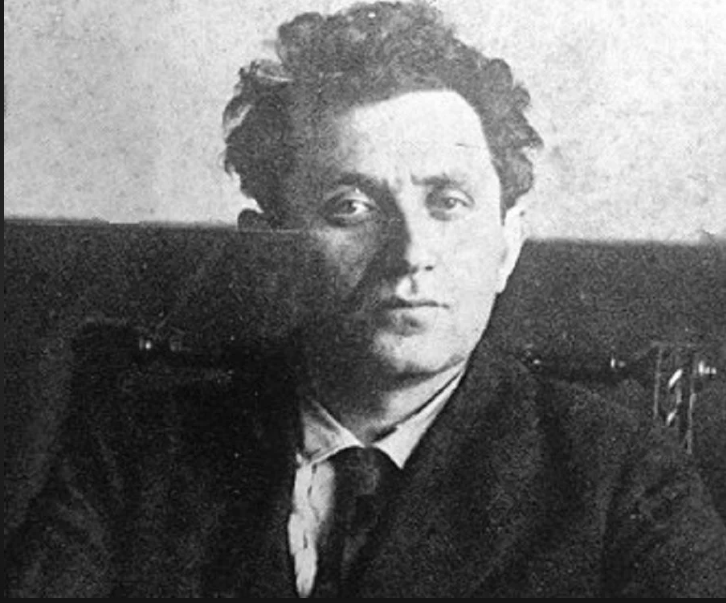
The historical shorthand goes that the ‘Zinoviev Letter lost Labour the election’. Yes, in the election the Tories won by a landslide, winning 413 seats. But it was the Liberals, not Labour that collapsed.
Yes, Labour did lose 40 seats because they now faced the combined votes of both Tory and switching Liberal voters, but far from workers running scared from Labour because of the Zinoviev Letter, the Labour vote went UP by over 1.1 million votes! The Liberals however, gained only 40 seats, never to return as a major force, as the panicked middle classes switched to the Tories.
When capitalism grudgingly allows ‘democracy’, they want it to be of the Tweedledum – Tweedledee variety, as still evidenced today in the US – you have the ‘freedom’ to change deckchairs but the ship remains capitalist. In Britain up until the First World War, men could vote but their only choice was to be, in the words of Gilbert and Sullivan, ‘…maybe a little liberal, or else a little conservative’.
Labour was workers’ party
But the Zinoviev Letter episode polarised British society, and ensured that from now on, Labour was the workers’ party, not the once mighty Liberals. Tweedledum foolishly killed off Tweedledee. By launching the class war, British capitalism had finished off their former second line of defence, as workers were forced to make the conclusion that they wanted socialism, not limp liberalism.
Incredibly, the British ruling class spent the next five decades trying to pretend the letter was real, such was their embarrassment that Britain, the ‘home of democracy’ and the ‘mother of all parliaments’ could stoop to the subterfuge more associated with dictators and despots. They finally came clean in 1967 after a Sunday Times team published the evidence that, yes it had been produced by White Russian forgers, and yes British military intelligence picked up the forgery in Riga, and yes, it was leaked to the Tory media.
Case closed? Not for some people – during the 2019 general election as Jeremy Corbyn faced Boris Johnson, the Daily Mail was at it again, this time in the usual method of alt-right propaganda (of the ‘nudge, nudge, wink, wink, hey – just saying!’ variety). A feature was headlined:
“The Left has always insisted the infamous Zinoviev Letter exposed by the Daily Mail was a forgery. Now, 95 years on, a new book poses a tantalising question – was the red plot letter that helped kick out Labour GENUINE after all?” (Daily Mail, 12 October 2019).
Er, no it wasn’t, which even the Daily Mail grudgingly admitted in the final two paragraphs of the lengthy feature.
But the Tories don’t need forged letters to attack Labour. They will suck ‘scandals’ out of thin air regardless of if a Labour Leader is right-wing or on the left, whether from putting around rumours that Harold Wilson was a KGB agent, or to the smears of antisemitism against Jeremy Corbyn.
During elections, the Tories do not want the political debate around the failures of capitalism such as unemployment, low pay, social and health care, housing or unjust wars – that is as true today in 2024 as it was in 1924. They will always bring up diversions, whether top hats, ‘reds under the bed’, and the fear of the ‘other’, whether immigrants, boat people, the European Union, asylum seekers etc etc – take your pick.
From McDonald to Starmer
Yet Tory media attacks have produced the same naïve mantra from Labour’s right wing, from MacDonald to Starmer – ‘jettison any left-wing policies, say ‘me too’ to any Tory populist policy, and perhaps we’ll get the Tory media to support us’.
Labour leaders can bend over backwards until their ears touch their heels, but the Tory media will still go the attack. The British ruling class have always wanted to destroy the Labour Party. For them it is too risky a concept, one that was reaffirmed to their horror after Jeremy Corbyn’s shock leadership victory. They know that Labour, despite the protestations of Labour’s right wing, is linked deep into the mass trade union movement and as such is susceptible to pressure from the masses below. It may have given them the ‘gradualist’ (and class traitor) Ramsay MacDonald, but it also gave them Clement Atlee and 1945; and James Callaghan but also Michael Foot; and Tony Blair but also Jeremy Corbyn.
In the history of the Labour Party, there has only ever been one episode of the Tory media calling on people to vote Labour, and that was for Tony Blair in 1997. But that was at the height of the ‘New Labour’ project, where Blair had ditched Labour’s socialist Clause IV, and made loud noises about dumping the party’s trade union links, looking all set to transform Labour into a US-style Democrat Party. For that brief moment in history, the ruling class thought they had got their Tweedledee back.
When it became clear that the trade unions and Labour activists weren’t going anywhere and ‘New Labour’ fizzled out, it was back to ‘business as usual’ for the Tory media.
And no matter how far Starmer goes to try and appease them, it will be ‘business as usual’ again in the next election. Different day, same BS.

